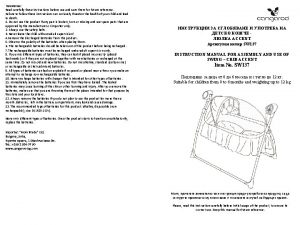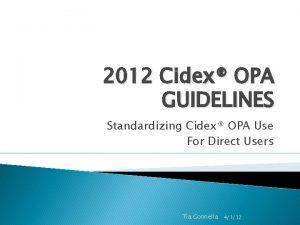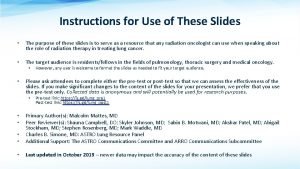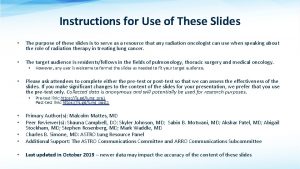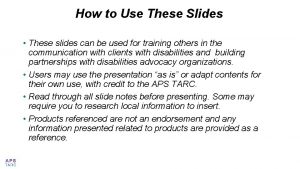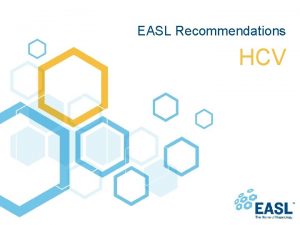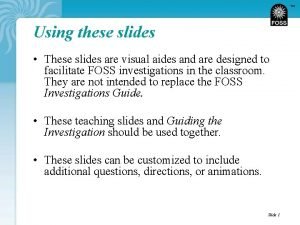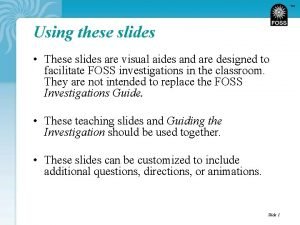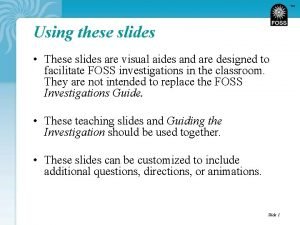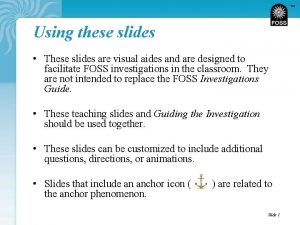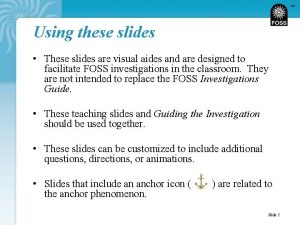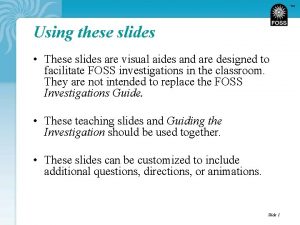Instructions for Use of These Slides The purpose


























































- Slides: 58

Instructions for Use of These Slides • The purpose of these slides is to serve as a resource that any radiation oncologist can use when speaking about the role of radiation therapy in treating skin cancers • The target audience is residents/fellows in the fields of Dermatology or Medical Oncology – • Please ask attendees to complete either the pre-test or post-test so that we can assess the effectiveness of the slides. If you make significant changes to the content of the slides for your presentation, we prefer that you use the pre-test only. – – • • However, any user is welcome to format them as needed for your target audience. Pre-test link: https: //is. gd/skin_pre 1 Post-test link: https: //is. gd/skin_post 1 Primary Author(s): Malcolm Mattes Peer Reviewer(s): Ashley Albert, Sabin Motwani, J. Ben Wilkinson, Anesa Ahamad, Caleb Dulaney, Benjamin Farnia, Aryavarta Kumar, Christopher Barker Additional Support: The ASTRO communications committee and ARRO communications subcommittee Last updated in April 2020– newer data may impact the accuracy of the content of these slides

Radiation Therapy as a Component of Multidisciplinary Skin Cancer Management

Learning Objectives • Understand basic principles of radiation therapy and the modalities used to deliver it for skin cancer • Discuss indications for definitive and adjuvant radiation therapy in the management of keratinocyte skin cancer • Understand expected skin toxicity from radiation and its management • Discuss the role of radiation therapy in the management of other cutaneous conditions

Background Information

Terminology • RT is used to treat cancer in the following ways: – Definitive RT is used instead of surgery as the primary curative treatment modality for the primary tumor and/or regional lymph nodes – Adjuvant RT is used after definitive surgery in patients at high risk of recurrence of their primary tumor and/or regional lymph nodes – Neoadjuvant RT is used before definitive surgery to downstage and enable a complete surgical resection – Palliative RT is used in metastatic patients for symptom relief • Each of these forms of radiation may be applicable to patients with skin cancer

How Does Radiation Work? 80% X-rays interact with water radiolysis free radicals bind to and damages DNA mitotic catastrophe 20% cell death Cancer cells are more susceptible to RT due to impaired DNA repair pathways

Radiation May Also Help Promote an Immune Response Relevant to advanced melanoma and SCC, which are commonly treated with immune checkpoint inhibitors

Radiation Dosing • Gray (Gy) is the unit of RT dose – 1 Gy = 100 centi. Gray (c. Gy) – The dose from 1 c. Gy roughly equals 1 CT scan • Dose prescription depends on: – Goal of treatment (curative > palliative) – Amount of disease (gross > microscopic) – RT sensitivity of tumor (melanoma > Sq. CC or BCC) – RT sensitivity of surrounding normal tissue

The Total Dose is Delivered in a Series of Daily Fractions • The biological effectiveness (or potency) of a RT regimen depends on both total dose and dose/fraction – Fractionation allows for DNA repair in normal tissue • Common prescriptions of definitive RT for keratinocyte carcinomas: – – 60 -70 Gy in 30 -35 fractions of 2 Gy 55 Gy in 20 fractions of 2. 75 Gy 50 Gy in 15 fractions of 3. 33 Gy 30 Gy in in 5 fractions of 6 Gy • Lower dose/fraction less long-term toxicity – Especially important in areas with very thin dermis (like the eyelid) or for larger field size • Pts typically treated 2 -5 days/week (skin brachytherapy 2/week) 30 -45 min/visit

Methods of Radiation Delivery For Skin Cancer Superficial or Orthovoltage Units deliver low energy X-rays Linear Accelerators deliver electrons or high energy X-rays

Methods of Radiation Delivery For Skin Cancer Brachytherapy uses a radioactive source to deliver gamma rays

Orthovoltage X-Rays vs. Electrons •

Potential Indications to Use Brachytherapy • When protracted daily fractionation is inconvenient for the patient • When the tumor has a more convex/irregular surface contour • Per institutional expertise

Examples of Brachytherapy • Interstitial brachytherapy may be useful for periorofacial tumors Interstitial brachytherapy to treat a SCC of the columella

Examples of Brachytherapy • Surface applicators may be useful for small, superficial tumors on a flat surface

Examples of Brachytherapy • Surface molds may be useful for superficial tumors <4 mm thickness on curved surfaces like the shin or hand

Cutaneous BCC and SCC Management

Risk Stratification Based on Tumor Location • Areas L (low), M (medium), and H (high) correlate with recurrence risk after definitive treatment Area H includes the mid-face where the embryonic fusion planes lie (easier for a tumor to penetrate)

NCCN High Risk Features for any Keratinocyte Skin Cancer • Location/size: – Area L > 20 mm – Area M > 10 mm – Area H (any size) • Poorly defined borders • Recurrent tumor (vs. primary) • Immunosuppression • Site of Prior RT • Perineural involvement

Additional High-Risk Features for Recurrence for BCC • Aggressive growth pattern – Having mixed infiltrative, micronodular, morpheaform, basosquamous, sclerosing, or carcinosarcomatous differentiation

Additional High-Risk Features for Recurrence for SCC • Site of chronic inflammatory process • Rapid tumor growth • Neurologic symptoms • Poorly differentiated • Adenoid (acantholytic), adenosquamous(showing mucin production), desmoplastic, or metaplastic (carcinosarcomatous) subtypes • Depth of invasion > 6 mm or into Sub. Q fat • Lymphatic or vascular involvement

Management of Keratinocyte Skin Cancers • Surgery is often most effective and efficient – However, consideration of function, cosmesis and patient preference may lead to choosing RT. – Shared decision-making between patient and providers is optimal • Cosmetic benefits of RT are most significant for tumors on or around the lips, nose, ears and eyelids.

Factors That May Favor Definitive RT Over Surgery • Older patients (less risk of late side effects) • Medically inoperable or debilitated patient • Larger (>5 mm) central face tumor – especially eyelids, tip/ala of the nose, lips • Larger (>5 mm) eyelid tumors where negative margins are not possible • Larger tumor of the ear, forehead, or scalp • Upper lip tumors

Factors Favoring Definitive Surgery Over RT • Prior RT to an involved area • Genetic conditions predisposing to skin cancer – Nevoid basal cell carcinoma (Gorlin) syndrome, xeroderma pigmentosum, ataxia telangiectasia, Li-Fraumeni syndrome • Conditions that increase risk of RT side effects – connective tissue diseases like scleroderma • Tumors of trunk and extremities, including dorsum of hand, bony prominences, belt line, below knees/ elbows • Larger/multifocal/deep tumors may have a better cure rate with surgery, though at the expense of functional/cosmetic impairment • Young Age

Comparing Outcomes of Treatment Modalities Summary of Reported Studies Low Risk Tumors Local Control High Risk Tumors Local Control Surgical Excision with Post-Operative Margin Assessment 90 -95% 83 -88% 99% 90 -94% 90 -96% 80 -88% Mohs Micrographic Surgery Radiation Therapy

Results of Treatment • Randomized evidence comparing RT to surgery for BCC of the face favors surgery in terms of both cosmesis and local control (Avril et al 1997, Petit et al 2000) – However, nuances in patient selection may favor RT in some cases • A more recent matched-pair cohort analysis of 369 patients (Patel et al 2017) treated with electron brachytherapy vs. Mohs showed 3 Y-LC rates of 99 -100% in both groups • Meta analysis (Drucker et al. 2018) of 40 RCTs show surgical treatments and external-beam radiation have low recurrence rates for the treatment of low-risk BCC • Locally advanced tumors (i. e. those involving cartilage, bone, nerve and/or muscle) have lower cure rates (50 -80%)

Radiation Target Volume • Typically covers entire tumor (or tumor bed) plus a 1 -2 cm margin radially and 0. 5 -1 cm in depth • May consider tighter margins if adjacent to critical normal structures • May consider more generous margins to cover a larger area of potential microscopic extension – Larger tumor (>2 cm), high grade tumor, recurrent tumor, tumor with indistinct borders, sclerosing BCC histology, location along embryonic fusion planes

Special Scenarios: The Eye • Areas outside of the tumor volume to shield/spare: – Lacrimal gland, to avoid xeropthalmia and keratoconjunctivitis – Lacrimal duct to avoid stricture and epiphora – The uninvolved eyelid to avoid ectropia or epilation of the eyelashes • A tungsten eye shield can protect the superficial structures of the eye and lens – Topical anesthetic facilitates shield placement – Antibiotic ointment after removal – Alternatively, can rotate the lens and cornea out of the beam by having the patient stare away from the beam during Tx • Brachytherapy can offer unique dosimetric advantages when treating periorbital, perioral, and nasal cutaneous targets • The above complications often can be treated with minor surgical procedures

Special Scenarios • Nose – Sloping surface may use tissue equivalent material on outside to ensure a flat surface and homogeneous dose – Lead strips coated with either wax or dental acrylic placed directly in the nose to shield the nasal septum and canal – Brachytherapy can also be used to treat these tumors instead of external beam radiotherapy • Mouth – Similar shields are placed under the lip to protect the gingiva and oral mucosa. – Brachytherapy can also be used to treat these tumors instead of external beam radiotherapy

Special Scenarios • Ear – A shield can be used behind the ear to treat auricle lesions – To minimize the irregular shape, may try to flatten the ear or put water in the concha and external auditory canal • Elderly Patients – Brachytherapy may be preferred if patient has limited mobility, and positioning for daily external beam RT may be challenging

Adjuvant RT for Basal Cell Carcinoma and Squamous Cell Carcinoma

Indications for Adjuvant RT to Tumor Bed for SCC • Close or positive margins than cannot be cleared surgically • Clinically or radiographically apparent perineural invasion (PNI) • Recurrent SCC s/p prior margin-negative resection • p. T 3 -4 (>4 cm, PNI, deep invasion >6 mm or beyond sub. Q fat, or invasion of bone, skull base, or foramen) • Desmoplastic or infiltrative tumors in chronically immunosuppressed patient Squamous cell carcinoma with perineural invasion

Indications for Adjuvant RT to Tumor Bed for BCC • Less data for adjuvant RT for BCC than SCC, since SCC is more aggressive • Usually recommended for: – Close or positive margins than cannot be cleared surgically – Recurrence s/p prior margin-negative resection – Locally advanced or neglected tumors involving bone or muscle

Addressing Perineural Invasion in Adjuvant RT • For clinical PNI or involvement of a named nerve of the H and N, cover nerve at risk to the base of skull Right supraorbital SCC with tumor spread along the frontal branch of V 1 to the superior orbital fissure (red arrow) is covered into the cavernous sinus in this case. • For microscopic PNI, may not need to cover as much

Management of Positive Lymph Nodes • If operable regional LND – Adjuvant RT for multiple involved LNs or extranodal extension • If inoperable definitive RT – Minimal evidence for concurrent chemotherapy • Regional nodes are generally not treated electively in node-negative patients with high-risk primary tumors – May consider elective nodal RT if already treating tumor bed, and target volume overlaps much of draining lymphatics

Nodal Regions

Nodal RT Techniques AP/PA 3 -D CRT VMAT IMRT Recent advancements in radiation techniques provide better sparing of normal structures.

Radiotherapy Toxicity

Radiation Toxicity • Depends on: – Site of the body being irradiated – Total dose and dose/fraction – Technique of radiation delivery • Classified as: – Acute effects – within days or weeks, in tissues with rapid turnover • Common, easier to treat – Late effects – after months or years, primarily in slowly proliferating tissues • Less common, harder to treat • Usually what limits our dose prescription

Acute Skin Toxicity from RT • Erythema – Earliest noticeable radiation effect • Dry Desquamation (peeling) – Occurs at intermediate dose levels • Moist desquamation – Expected at doses required to control skin cancers – Due to death of basal cells in the epidermis; new cell proliferation does not keep up with cell loss exposure of the dermis + serous oozing – Epidermal re-growth occurs from the periphery and from the more resistant epithelial cells around hair follicles (this new skin is thin and atrophic so take extra care to prevent injury) – Healing occurs within 3 -5 weeks following Tx, but in severe cases symptoms may last months

Management of Acute Skin Toxicity • Prevention: – Avoid friction/trauma (e. g. shaving, scratching or sun exposure) – Avoid cosmetics or harsh cleansers (especially if contain alcohol) • For erythema or dry desquamation: – Emollients (lotions, creams, or ointments) – Gentle cleansing with mild soap and patted dry – Topical corticosteroids (controversial) • For moist desquamation: – – – Dilute H 2 O 2 or 1% aqueous gentian violet to dry the lesion and prevent infection Silver sulfadiazine 1% cream promotes healing. For minimally exudative wounds Hydrogel or Hydrocolloid dressing For highly exudative wounds burn pads, alginate, or foam dressing For infected wounds ion silver pads or powder, topical ABx

Other Acute Skin Toxicities • Hyperpigmentation due to melanocyte stimulation – Usually resolves within 3 months but can become permanent in some patients • Temporary alopecia occurs when hair follicles shed and cells move into resting phase of cell cycle. – Usually hair grows back in 3 -5 months • Radiation Recall is an acute inflammatory response in a previously irradiated field following administration of a systemic drug (anthracyclines, taxanes, alkylating agents, anti-metabolites, gemcitabine, hormonal therapies, immunotherapy, antimicrobials, etc. ) – May occur days to years after RT – Onset is days to 2 months after drug administration

Long Term Cosmetic Outcomes are Often Very Good However, like any cancer treatment modality, radiation cause long term toxicity too.

Potential Long Term Skin Toxicity from Definitive RT • Telangiectasia formation due to capillaries being reduced in number and dilated • Destruction of melanocytes, hair follicles, and sebaceous/sweat glands in the RT field may permanent hypopigmentation or alopecia • Chronic dermatitis can develop months-years after RT

Other Potential Late Toxicity from Definitive RT • Radiation necrosis of the skin – Can occur months to years after RT – Due to poor vascularity and atrophy, and usually precipitated by trauma – 3% incidence using < 4 Gy/fraction • Chondronecrosis or osteonecrosis – Currently very uncommon using modern techniques and equipment, even if tumor involves cartilage or bone • RT-induced malignancy (in treated field) – Typically occur 5+ years after RT – May behave more aggressively

Radiation Therapy for Other Malignant and Benign Cutaneous Conditions

Malignant Melanoma • Surgery is the primary treatment modality • Adjuvant primary tumor bed RT may be considered for desmoplastic melanoma with high-risk features: – – H and N location, extensive neurotropism pure desmoplastic melanoma histology close margins that cannot be re-resected prior local recurrence

Malignant Melanoma • Adjuvant nodal bed RT may be considered for high-risk nodal features: – – – – Extranodal extension > 1 parotid node > 2 cervical or axillary nodes > 3 inguinofemoral nodes > 3 cm cervical or axillary node > 4 cm inguinofemoral node prior nodal recurrence

Other Indications for RT for Melanoma • Palliative RT is commonly used for brain or visceral metastasis – Radiosurgery (high dose/fraction) is preferred • Definitive RT to the primary tumor and/or involved nodes is rarely used – May be indicated if patient medically inoperable • SBRT for oligometastatic disease • Immunotherapy does not need to be held during RT, but BRAF and MEK inhibitors do

Merkel Cell Carcinoma • Surgery is the primary treatment modality – Usually WLE with 1 -2 cm margins – If SLN or FNA is pathologically positive full regional LND and/or RT

Adjuvant RT for Merkel Cell Carcinoma • 25 -30% of patients have local recurrence after surgery alone Most patients get adjuvant RT (5066 Gy) • Observation without RT may be considered for tumors < 1 cm without any high-risk features • Target volume includes larger margins (3 -5 cm) to cover in-transit metastases

Data Supporting Adjuvant RT for Merkel Cell Carcinoma •

Keloids • Adjuvant RT given shortly after surgical excision substantially lowers recurrence rate

Dermatofibrosarcoma Protuberans • Adjuvant RT indicated if (+) margins • Definitive RT only if unresectable

Cutaneous T-Cell Lymphoma or Mycosis Fungoides • Total Skin Electron Beam Therapy

Take-Home Points • Though surgery is the mainstay of treatment for most cutaneous malignancies, RT has an integral role in the definitive and adjuvant management for a variety of patients and tumor types. • The expected cosmetic benefits of definitive RT for keratinocyte carcinomas is likely to be most significant for larger tumors on or around the lips, nose, ears and eyelids. • Multidisciplinary consultations and shared decision-making are appropriate for patients with keratinocyte carcinomas of borderline operability, or when surgery would render a relatively poor cosmetic outcome. • Post-op RT for cutaneous SCC is recommended for T 3 -4 stage, gross PNI, close or positive margins, and recurrence after a prior margin-negative resection.

References 1. NCCN: https: //www. nccn. org/professionals/physician_gls/default. aspx 2. Up. To. Date: https: //www. uptodate. com/home 3. Albert A, Knoll MA, Conti JA, Zbar RIS. Non-Melanoma Skin Cancers in the Older Patient. Curr Oncol Rep. 2019 Jul 29; 21(9): 79. 4. Avril MF, Auperin A, Margulis A, Gerbaulet A, Duvillard P, Benhamou E, Guillaume JC, Chalon R, Petit JY, Sancho-Garnier H, Prade M, Bouzy J, Chassagne D. Basal cell carcinoma of the face: surgery or radiotherapy? Results of a randomized study. Br J Cancer. 1997; 76(1): 100 -6. 5. Bakst RL, Glastonbury CM, Parvathaneni U, et al. Perineural Invasion and Perineural Tumor Spread in Head and Neck Cancer. Int J Radiat Oncol Biol Phys. 2019 Apr 1; 103(5): 1109 -1124. 6. Baxter J, Patel A, Varma S. Facial basal cell carcinoma. BMJ. 2012 Aug 21; 345: e 5342. 7. Guinot JL, Rembielak A, Perez-Calatayud J, et al. GEC-ESTRO ACROP recommendations in skin brachytherapy. Radiother Oncol. 2018 Mar; 126(3): 377 -385. 8. Henderson MA, Burmeister BH, Ainslie J, et al. Adjuvant lymph-node field radiotherapy versus observation only in patients with melanoma at high risk of further lymph-node field relapse after lymphadenectomy (ANZMTG 01. 02/TROG 02. 01): 6 -year follow-up of a phase 3, randomised controlled trial. Lancet Oncol. 2015 Sep; 16(9): 1049 -1060.

References 9. Ho C, Argáez C. Mohs Surgery for the Treatment of Skin Cancer: A Review of Guidelines [Internet]. Ottawa (ON): Canadian Agency for Drugs and Technologies in Health; 2019 Mar 20. 10. Kim, K, Son D, Kim J. Radiation Therapy Following Total Keloidectomy: A Retrospective Study over 11 Years. Archives of Plastic Surgery 2015; 42(5): 588 -95 11. Likhacheva A, Awan M, Barker CA, et al. Definitive and Postoperative Radiation Therapy for Basal and Squamous Cell Cancers of the Skin: Executive Summary of an American Society for Radiation Oncology Clinical Practice Guideline. Pract Radiat Oncol. 2020 Jan - Feb; 10(1): 8 -20. 12. Locke J, Karimpour S, Young G, Lockett MA, Perez CA. Radiotherapy for epithelial skin cancer. Int J Radiat Oncol Biol Phys. 2001 Nov 1; 51(3): 748 -55. 13. Mattes MD, Zhou Y, Berry SL, Barker CA. Dosimetric comparison of axilla and groin radiotherapy techniques for highrisk and locally advanced skin cancer. Radiat Oncol J. 2016 Jun; 34(2): 145 -55. 14. Patel R, Strimling R, Doggett S, Willoughby M, Miller K, Dardick L, Mafong E. Comparison of electronic brachytherapy and Mohs micrographic surgery for the treatment of early-stage non-melanoma skin cancer: a matched pair cohort study. J Contemp Brachytherapy. 2017 Aug; 9(4): 338 -344. 15. Petit JY, Avril MF, Margulis A, Chassagne D, Gerbaulet A, Duvillard P, Auperin A, Rietjens M. Evaluation of cosmetic results of a randomized trial comparing surgery and radiotherapy in the treatment of basal cell carcinoma of the face. Plast Reconstr Surg. 2000 Jun; 105(7): 2544 -51. 16. Petrelli F, Ghidini A, Torchio M, et al. Adjuvant radiotherapy for Merkel cell carcinoma: A systematic review and meta -analysis. Radiother Oncol. 2019 May; 134: 211 -219. 17. Vatner RE, Cooper BT, Vanpouille-Box C, Demaria S, Formenti SC. Combinations of immunotherapy and radiation in cancer therapy. Front Oncol. 2014 Nov 28; 4: 325.
 A small child slides down the four frictionless slides
A small child slides down the four frictionless slides Energy of four forces quick check
Energy of four forces quick check These slides
These slides These slides
These slides These slides
These slides Purpose driven church powerpoint slides
Purpose driven church powerpoint slides Optical discs store items by using microscopic
Optical discs store items by using microscopic Please read instructions carefully before use
Please read instructions carefully before use Imperatives
Imperatives Please read instructions carefully before use
Please read instructions carefully before use Cidex thermometer
Cidex thermometer It holds data instructions and information for future use
It holds data instructions and information for future use Please read instructions carefully before use
Please read instructions carefully before use An author's purpose in using rhetoric is to
An author's purpose in using rhetoric is to The common purpose of these legislative acts was to
The common purpose of these legislative acts was to Fspos
Fspos Typiska drag för en novell
Typiska drag för en novell Tack för att ni lyssnade bild
Tack för att ni lyssnade bild Vad står k.r.å.k.a.n för
Vad står k.r.å.k.a.n för Varför kallas perioden 1918-1939 för mellankrigstiden?
Varför kallas perioden 1918-1939 för mellankrigstiden? En lathund för arbete med kontinuitetshantering
En lathund för arbete med kontinuitetshantering Adressändring ideell förening
Adressändring ideell förening Personlig tidbok
Personlig tidbok Sura för anatom
Sura för anatom Förklara densitet för barn
Förklara densitet för barn Datorkunskap för nybörjare
Datorkunskap för nybörjare Stig kerman
Stig kerman Debatt artikel mall
Debatt artikel mall Delegerande ledarstil
Delegerande ledarstil Nyckelkompetenser för livslångt lärande
Nyckelkompetenser för livslångt lärande Påbyggnader för flakfordon
Påbyggnader för flakfordon Formel för lufttryck
Formel för lufttryck Offentlig förvaltning
Offentlig förvaltning Kyssande vind analys
Kyssande vind analys Presentera för publik crossboss
Presentera för publik crossboss Teckenspråk minoritetsspråk argument
Teckenspråk minoritetsspråk argument Bat mitza
Bat mitza Klassificeringsstruktur för kommunala verksamheter
Klassificeringsstruktur för kommunala verksamheter Epiteltyper
Epiteltyper Claes martinsson
Claes martinsson Centrum för kunskap och säkerhet
Centrum för kunskap och säkerhet Byggprocessen steg för steg
Byggprocessen steg för steg Bra mat för unga idrottare
Bra mat för unga idrottare Verktyg för automatisering av utbetalningar
Verktyg för automatisering av utbetalningar Rutin för avvikelsehantering
Rutin för avvikelsehantering Smärtskolan kunskap för livet
Smärtskolan kunskap för livet Ministerstyre för och nackdelar
Ministerstyre för och nackdelar Tack för att ni har lyssnat
Tack för att ni har lyssnat Referatmarkering
Referatmarkering Redogör för vad psykologi är
Redogör för vad psykologi är Matematisk modellering eksempel
Matematisk modellering eksempel Atmosfr
Atmosfr Borra hål för knoppar
Borra hål för knoppar Orubbliga rättigheter
Orubbliga rättigheter Stickprovsvarians
Stickprovsvarians Tack för att ni har lyssnat
Tack för att ni har lyssnat Rita perspektiv
Rita perspektiv Vad är verksamhetsanalys
Vad är verksamhetsanalys Tobinskatten för och nackdelar
Tobinskatten för och nackdelar









